Submitted by chandra on Wed, 2010-06-02 13:57
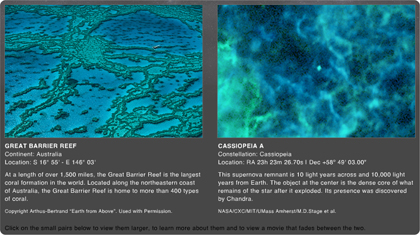
There are a lot of reasons why people like astronomy. For some, it's the topics it covers like black holes, exploded stars, and distant planets. For others, it's the sense of awe that the cosmos inspires. There are also lots of people that just think the images are beautiful and worth gazing at. And, for most, it’s some combination of these and others that make them want to learn more about astronomy.
Submitted by chandra on Tue, 2010-05-25 14:08
This week, astronomers have gathered in the balmy city of Miami for the 216th meeting of the American Astronomical Society meeting. There are some interesting Chandra results – the new image of N49 and the latest on the black hole in Andromeda – but so much more. There has been news on the latest from the WISE mission, new stuff on exoplanets, some spectacular images and movies of the Sun from the Solar Dynamics Observatory – and that's just the first two days. Keep an eye on your favorite astronomy news website for the latest.
-M.Watzke, CXC
Submitted by chandra on Tue, 2010-05-25 13:54
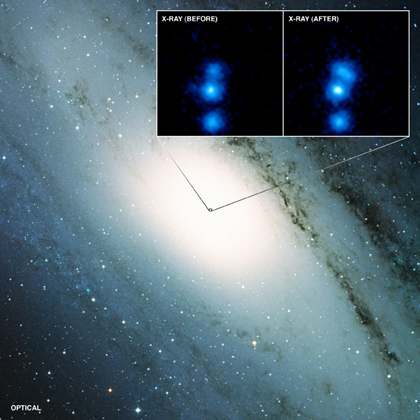
The large image here shows an optical view, with the Digitized Sky Survey, of the Andromeda Galaxy, otherwise known as M31. The inset shows Chandra X-ray Observatory images of a small region in the center of Andromeda. The image on the left shows the sum of 23 images taken with Chandra's High Resolution Camera (HRC) before January 2006 and the image on the right shows the sum of 17 HRC images taken after January 2006. Before 2006, three X-ray sources are clearly visible in the Chandra image, including one faint source close to the center of the image. After 2006, a fourth source, called M31*, appears just below and to the right of the central source, produced by material falling onto the supermassive black hole in M31.
More: http://www.chandra.harvard.edu/photo/2010/m31/
Carnival of Space
-M.Watzke, CXC
Submitted by chandra on Mon, 2010-05-24 10:07
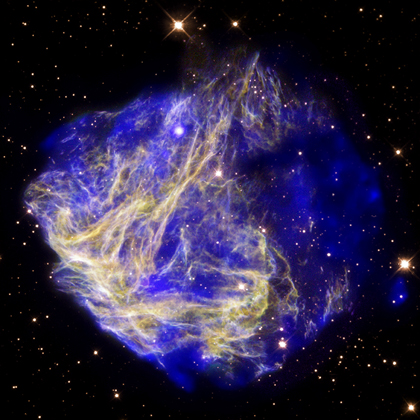
This beautiful composite image shows N49, the aftermath of a supernova explosion in the Large Magellanic Cloud. A new long observation from NASA's Chandra X-ray Observatory, shown in blue, reveals evidence for a bullet-shaped object being blown out of a debris field left over from an exploded star.
Submitted by chandra on Tue, 2010-05-11 12:07
A new exhibition connecting art and science opens May 12th outdoors in the garden of the John Nicholas Brown Center at Brown University in Providence, RI. The exhibition features X-ray images of the cosmos from NASA’s orbiting Chandra X-ray Observatory, X-ray images of paintings from the Harvard Art Museum, as well as pieces by artist Roxanne Crocker of the Rhode Island School of Design. Entitled "Sight Lines: Looking Back, Seeing Through," the exhibition is free and open to the public during daylight hours from May 12 through May 31, 2010.
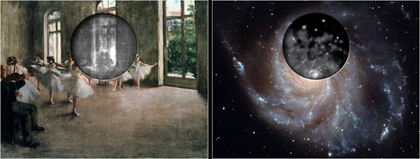
Submitted by chandra on Tue, 2010-05-11 11:23
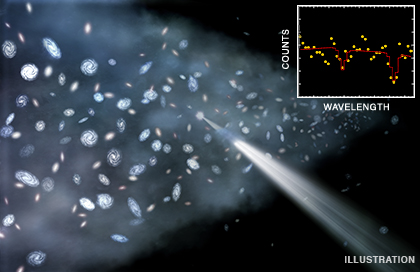
Scientists have used NASA's Chandra X-ray Observatory and ESA's XMM-Newton to detect a vast reservoir of gas lying along a wall-shaped structure of galaxies about 400 million light years from Earth. In this artist's impression, a close-up view of the so-called Sculptor Wall is depicted. Spiral and elliptical galaxies are shown in the wall along with the newly detected intergalactic gas, part of the so-called Warm Hot Intergalactic Medium (WHIM), shown in blue. This discovery is the strongest evidence yet that the "missing matter" in the nearby Universe is located in an enormous web of hot, diffuse gas.
Submitted by chandra on Fri, 2010-05-07 07:47
For those of you who are still making 4th of July plans and might be in Washington, DC, for the holiday, here's something to consider. There will be a Chandra exhibit at this summer’s Smithsonian Folklife Festival from July 3-5. Why, you might ask? Well, one of the themes of this year’s festival is the "Unlocking the Mysteries of the Universe" -- and that's basically right up our alley. Throw in the fact that Chandra is operated and managed by the Smithsonian Astrophysical Observatory, and it's practically a match made in heaven.
Submitted by chandra on Wed, 2010-04-28 10:58
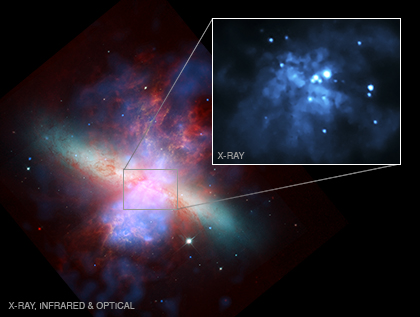
This composite image of the nearby starburst galaxy M82 shows Chandra X-ray Observatory data in blue, optical data from the Hubble Space Telescope in green and orange, and infrared data from the Spitzer Space Telescope in red. The pullout is a Chandra image that shows the central region of the galaxy and contains two bright X-ray sources -- identified in a labeled version, roll your mouse over the image to view -- of special interest.
Submitted by chandra on Thu, 2010-04-22 13:51
Maybe it's the large number of the pre-school people that we spend time with these days, but we see shapes all over the place. Hoping to go beyond the snack-and-nap crowd, we like to look for similar shapes in very unexpected places.

A demonstration of visuals for bubbles (soap bubble, bubble nebula, galaxy cluster bubbles) across different scales.
Submitted by chandra on Thu, 2010-04-15 12:41
Since the dawn of the Internet, there have been countless things that have come and gone. To some of them, we can easily say good riddance (flashing rainbow icons? the used-to-death phrase of the "information superhighway"?)

In other words, not many vestiges of the Internet circa 1996 remain, but one important one does: the Webby awards. Presented by the International Academy of Digital Arts and Sciences, the Webbies are still one of the most prestigious digital awards around.
Pages